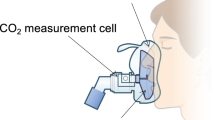Abstract
We describe and evaluate a new apparatus that monitors end-tidal carbon dioxide (PetCO2) and augments the inspired oxygen concentration in awake, sedated patients. The unit was evaluated for its effectiveness as an oxygenation device and its accuracy as a predictor of PaCO2 through the correlation of PaCO2 withPetCO2. Twenty cardiac surgical patients, physical status ASA 2–4, participated in this study. ThePetCO2 monitoring device consisted of a dual-prong nasal oxygen cannula and a 14-gauge intravenous catheter that was inserted into one limb of the oxygen supply tubing and connected to a Datex gas analyzer (Datex Instrumentation Corp, Helsinki, Finland) to measurePetCO2. The cross-over passage between the prongs was intentionally blocked with the end of a wooden-core cotton swab. The oxygen flow rates were randomly varied (2, 4, and 6 L/min) every 5 minutes, and values forPetCO2 as well as arterial blood samples for analysis of PaCO2 and PaO2 were obtained at the end of each 5-minute period. The accuracy of the system was assessed by comparing the PaCO2-PetCO2 differences (bias) at each oxygen flow rate. The ratios ofPetCO2 compared with PaCO2 were 0.98, 0.94, and 0.85, with correlation coefficients ofr=0.81, 0.85, and 0.63, respectively. The PaO2 values were 114, 154, and 183 mm Hg for the corresponding nasal oxygen flow rates of 2, 4, and 6 L/min, respectively. This study indicates that this modified nasal cannula provides supplemental oxygen adequately and yields a satisfactory reflection of the PaCO2 depending on the oxygen flow rate delivered.
Similar content being viewed by others
References
Ibarra E, Lees DE. Mass spectrophotometer monitoring of patients with regional anesthesia. Anesthesiology 1985;63:572–573
Norman EA, Zeig NJ, Ahmad I. Better designs for mass spectrometer monitoring of the awake patient. Anesthesiology 1986;64:664
Huntington CT, King HK. A simpler design for mass spectrometer monitoring of the awake patient. Anesthesiology 1986;65:565–566
Goldman JM. A simple, easy, and inexpensive method for monitoring ETCO2 through nasal cannulae. Anesthesiology 1987;67:606
Pressman MA. A simple method of measuring ET-CO2 during MAC and major regional anesthesia. Anesth Analg 1988;67:905–906
Louwsma DL, Silverman DG. Reproducibility of end tidal CO2 measurements in sedated patients receiving supplemental O2 by nasal cannula. Anesthesiology 1988;69:A268
Bowe EA, Boysen PG, Broome JA, Klein EF. Accurate determination of end-tidal carbon dioxide during administration of oxygen by nasal cannulae. J Clin Monit 1989;5:105–110
Dunphy JA. Accuracy of expired carbon dioxide partial pressure sampled from a nasal cannula II. Anesthesiology 1988;68:960–961
Barr, PO. Pulmonary gas exchange in man as affected by prolonged gravitational stress. Acta Physiol Scand Suppl 1963;207:1–46
Jones NL, Robertson DG, Kane JW. Difference between end-tidal and arterial pCO2. J Appl Physiol 1979;47:954–960
Shankar KB, Moseley H, Kumar Y, Vemula V. Arterial to end tidal carbon dioxide tension difference during caesarean section anesthesia. Anaesthesia 1986;41:698–702
From RP, Scammen FL. Ventilatory frequency influences accuracy of end-tidal CO2 measurements: analysis of seven capnometers. Anesth Analg 1988;67:884–886
Severinghaus JW. Water vapor calibration errors in some capnometers: respiratory conventions misunderstood by manufacturers? Anesthesiology 1989;70:996–998
Author information
Authors and Affiliations
Rights and permissions
About this article
Cite this article
Roy, J., McNulty, S.E. & Torjman, M.C. An improved nasal prong apparatus for end-tidal carbon dioxide monitoring in awake, sedated patients. J Clin Monitor Comput 7, 249–252 (1991). https://doi.org/10.1007/BF01619269
Received:
Revised:
Accepted:
Issue Date:
DOI: https://doi.org/10.1007/BF01619269




